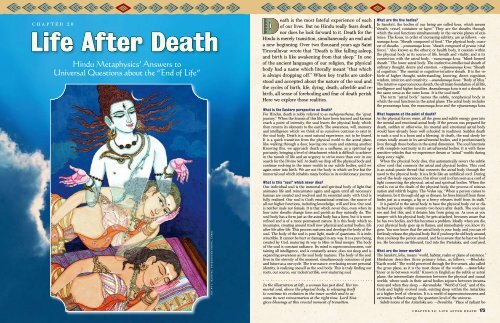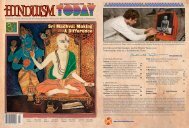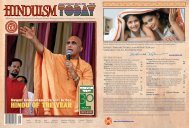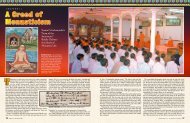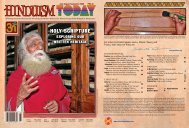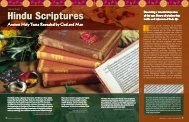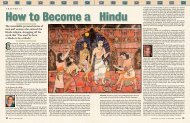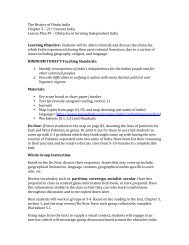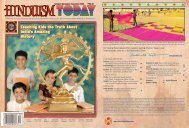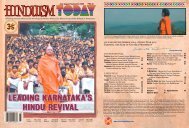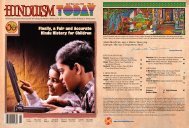Life After Death - Hinduism Today Magazine
Life After Death - Hinduism Today Magazine
Life After Death - Hinduism Today Magazine
Create successful ePaper yourself
Turn your PDF publications into a flip-book with our unique Google optimized e-Paper software.
chapter 20<br />
<strong>Life</strong> <strong>After</strong> <strong>Death</strong><br />
Hindu Metaphysics’ Answers to<br />
Universal Questions about the “End of <strong>Life</strong>”<br />
What are the inner worlds?<br />
The Sanskrit, loka, means “world, habitat, realm or plane of existence.”<br />
<strong>Hinduism</strong> describes three primary lokas, as follows. —Bhuloka:<br />
“Earth world.” The world perceived through the five senses, also called<br />
the gross plane, as it is the most dense of the worlds. —Antarloka:<br />
“Inner or in-between world.” Known in English as the subtle or astral<br />
plane, the intermediate dimension between the physical and causal<br />
worlds, where souls in their astral bodies sojourn between incarnations<br />
and when they sleep. —Karanaloka: “World of God,” and of the<br />
Gods and highly evolved souls, existing deep within the Antarloka<br />
at a higher level of vibration. It is a world of superconsciousness and<br />
extremely refined energy, the quantum level of the universe.<br />
Subdivisions of the Antarloka are: —Devaloka: “Place of radiant bea.<br />
manivel<br />
art by a. manivel; background photo, Corel<br />
D<br />
eath is the most fateful experience of each<br />
of our lives. But no Hindu really fears death,<br />
nor does he look forward to it. <strong>Death</strong> for the<br />
Hindu is merely transition, simultaneously an end and<br />
a new beginning. Over two thousand years ago Saint<br />
Tiruvalluvar wrote that “<strong>Death</strong> is like falling asleep,<br />
and birth is like awakening from that sleep.” In one<br />
of the ancient languages of our religion, the physical<br />
body had a name which literally meant “that which<br />
is always dropping off.” When key truths are understood<br />
and accepted about the nature of the soul and<br />
the cycles of birth, life, dying, death, afterlife and rebirth,<br />
all sense of foreboding and fear of death perish.<br />
Here we explore those realities.<br />
What is the Eastern perspective on <strong>Death</strong>?<br />
For Hindus, death is nobly referred to as mahaprasthana, the “great<br />
journey.” When the lessons of this life have been learned and karmas<br />
reach a point of intensity, the soul leaves the physical body, which<br />
then returns its elements to the earth. The awareness, will, memory<br />
and intelligence which we think of as ourselves continue to exist in<br />
the soul body. <strong>Death</strong> is a most natural experience, not to be feared.<br />
It is a quick transition from the physical world to the astral plane,<br />
like walking through a door, leaving one room and entering another.<br />
Knowing this, we approach death as a sadhana, as a spiritual opportunity,<br />
bringing a level of detachment which is difficult to achieve<br />
in the tumult of life and an urgency to strive more than ever in our<br />
search for the Divine Self. At death we drop off the physical body and<br />
continue evolving in the inner worlds in our subtle bodies, until we<br />
again enter into birth. We are not the body in which we live but the<br />
immortal soul which inhabits many bodies in its evolutionary journey.<br />
What is this “soul” which never dies?<br />
Our individual soul is the immortal and spiritual body of light that<br />
animates life and reincarnates again and again until all necessary<br />
karmas are created and resolved and its essential unity with God is<br />
fully realized. Our soul is God’s emanational creation, the source of<br />
all our higher functions, including knowledge, will and love. Our soul<br />
is neither male nor female. It is that which never dies, even when its<br />
four outer sheaths change form and perish as they naturally do. The<br />
soul body has a form just as the astral body has a form, but it is more<br />
refined and is of a more permanent nature. It is this body which reincarnates,<br />
creating around itself new physical and astral bodies, life<br />
after life after life. This process matures and develops the body of the<br />
soul. The body of the soul is pure light, made of quantums. It is indestructible.<br />
It cannot be hurt or damaged in any way. It is a pure being,<br />
created by God, maturing its way to Him in final merger. The body<br />
of the soul is constant radiance. Its mind is superconsciousness, containing<br />
all intelligence, and is constantly aware, does not sleep and is<br />
expanding awareness as the soul body matures. The body of the soul<br />
lives in the eternity of the moment, simultaneously conscious of past<br />
and future as a one cycle. The true nature, everlasting secure personal<br />
identity, is realizing oneself as the soul body. This is truly finding our<br />
roots, our source, our indestructible, ever-maturing soul.<br />
In the illustration at left, a woman has just died. Her immortal<br />
soul, above the physical body, is releasing itself<br />
to continue its evolution in the inner worlds and to assume<br />
its next reincarnation at the right time. Lord Siva<br />
gives blessings at this crucial moment of transition.<br />
What are the five bodies?<br />
In Sanskrit, the bodies of our being are called kosa, which means<br />
“sheath, vessel, container or layer.” They are the sheaths through<br />
which the soul functions simultaneously in the various planes of existence.<br />
The kosas, in order of increasing subtlety, are as follows: —annamaya<br />
kosa: “Sheath composed of food.” The physical body, coarsest<br />
of sheaths. —pranamaya kosa: “sheath composed of prana (vital<br />
force).” Also known as the etheric or health body, it coexists within<br />
the physical body as its source of life, breath and vitality, and is its<br />
connection with the astral body. —manomaya kosa: “Mind-formed<br />
sheath.” The lower astral body. The instinctive-intellectual sheath of<br />
ordinary thought, desire and emotion. —vijnanamaya kosa: “Sheath<br />
of cognition.” The mental or cognitive-intuitive sheath. It is the vehicle<br />
of higher thought, understanding, knowing, direct cognition,<br />
wisdom, intuition and creativity. —anandamaya kosa: “Body of bliss.”<br />
The intuitive-superconscious sheath, the ultimate foundation of all life,<br />
intelligence and higher faculties. Anandamaya kosa is not a sheath in<br />
the same sense as the outer kosas. It is the soul itself.<br />
The term “astral body” names the subtle, nonphysical body in<br />
which the soul functions in the astral plane. The astral body includes<br />
the pranamaya kosa, the mano maya kosa and the vijnanamaya kosa.<br />
What happens at the point of death?<br />
As the physical forces wane, all the gross and subtle energy goes into<br />
the mental and emotional astral body. If the person was prepared for<br />
death, sudden or otherwise, his mental and emotional astral body<br />
would have already been well schooled in readiness. Sudden death<br />
to such a soul is a boon and a blessing. At death, the soul slowly becomes<br />
totally aware in its astral/mental bodies, and it predominantly<br />
lives through those bodies in the astral dimension. The soul functions<br />
with complete continuity in its astral/mental bodies. It is with these<br />
sensitive vehicles that we experience dream or “astral” worlds during<br />
sleep every night.<br />
When the physical body dies, this automati cally severs the subtle<br />
silver cord that connects the astral and physical bodies. This cord<br />
is an astral-pranic thread that connects the astral body through the<br />
navel to the physical body. It is a little like an umbilical cord. During<br />
out-of-the-body experiences, this silver cord is often seen as a cord of<br />
light connecting the physical, astral and spiritual bodies. When the<br />
cord is cut at the death of the physical body, the process of reincarnation<br />
and rebirth begins. The Vedas say, “When a person comes to<br />
weakness, be it through old age or disease, he frees himself from these<br />
limbs just as a mango, a fig or a berry releases itself from its stalk.”<br />
It is painful to the astral body to have the physical body cut or disturbed<br />
seriously within seventy-two hours after death. The soul can<br />
see and feel this, and it detains him from going on. As soon as you<br />
tamper with his physical body, he gets attached, becomes aware that<br />
he has two bodies, and this becomes a problem. Ideally when you die,<br />
your physical body goes up in flames, and immediately you know it’s<br />
gone. You now know that the astral body is your body, and you can effortlessly<br />
release the physical body. But if you keep the old body around,<br />
then you keep the person around, and he is aware that he has two bodies.<br />
He becomes earthbound, tied into the Pretaloka, and confused.<br />
chapter 20: life after death 173
ings.” The higher astral plane, or mental plane, the<br />
realm of “angels.” —Pretaloka: “World of the departed.”<br />
The realm of earth-bound souls, or ghosts.<br />
It is an astral duplicate of the physical world and<br />
closest to it. —Narakaloka: Abode of darkness.<br />
The lower worlds, realm of “demons.” Equivalent<br />
to the Western term “hell,” a gross region of the<br />
Antarloka. A congested, distressful area where<br />
beings suffer the consequences of their own misdeeds<br />
in previous lives. Described as a place of<br />
torment, pain, darkness, confusion and disease.<br />
Narakaloka is not a place where souls reside forever.<br />
<strong>Hinduism</strong> has no eternal hell.<br />
What determines where one goes after death?<br />
Where the soul goes in the astral plane at sleep or<br />
death is dependent upon his earthly pursuits and<br />
the quality of his mind. If the soul body itself is<br />
evolved, it will occupy the astral/mental bodies<br />
in the Deva loka. If somebody dies in the states of<br />
anger and fear, he goes into the lower worlds of<br />
those states of consciousness. And in that realm<br />
there would be hundreds of thousands of people<br />
in that same state of consciousness. The thoughts<br />
at death are the next samskaras of the astral body.<br />
Even if you have the thought, “When you’re dead<br />
you’re dead,” your astral body might just float over<br />
your physical body and be “dead.” A lot of people<br />
who are about to die do not believe in life after<br />
death, so they remain hovering over their physical<br />
body when it is lifeless. Astral-plane helpers have<br />
to come and “wake them up” and tell them that<br />
their physical body is dead and explain that they<br />
are all right and are alive in their astral body. It is<br />
often not easy getting them readjusted.<br />
At death you leave through a nerve ganglia of<br />
consciousness, a chakra. Each chakra is a window,<br />
and at death it becomes a portal, a doorway. The<br />
tunnel of light that is experienced by so many<br />
people at the point of death is the portal they<br />
are going through, the window, the chakra. Passing<br />
through the tunnel is leaving this world and<br />
going into another. So, it is the state of mind at<br />
death that gets you into one loka or another. At<br />
the moment of death, you have the opportunity to<br />
stabilize yourself in the highest chakra you have<br />
experienced in this life. The dying should always<br />
remember that the place where one will reincarnate<br />
is the place that he is thinking about prior<br />
to death. So, choose your desires wisely. The last<br />
thoughts just before death are the most powerful<br />
thoughts in creating the next life. Secret questionings<br />
and doubt of Hindu belief, and associations<br />
with other belief systems will automatically place<br />
him among like-minded people whose beliefs are<br />
alien to Hin duism. A nominal Hindu on Earth<br />
could be a selfish materialist in the astral world.<br />
The Hindu also knows that death must come naturally,<br />
in its own course, and that suicide only accelerates<br />
the intensity of one’s karma, placing one in a<br />
In between: Having experienced death, a<br />
woman continues her spiritual journey in<br />
a refined area of the subtle worlds. Below<br />
her are depicted the lower regions of fear,<br />
anger and hurtfulness. The heavenly realm<br />
of the Gods is shown above and to her left.<br />
174 what is hinduism?<br />
a. manivel<br />
lengthy earth-bound limbo state in the astral plane,<br />
bringing a series of immediate lesser births and requiring<br />
several lives for the soul to return to the exact<br />
evolutionary point that existed at the moment<br />
of suicide, at which time the still-existing karmic<br />
entanglements must again be faced and resolved.<br />
What should one do to prepare for death?<br />
Everyone is prepared to die, and whether it happens<br />
suddenly or slowly, intuitively each individual<br />
knows exactly what he is experiencing and about<br />
to experience. You don’t need any counseling. It<br />
is a blessing to know when you are going to die,<br />
because then you can prepare for it, make a decision<br />
whether you are going to be reborn, do intense<br />
sadhanas, make preparations. When one knows he<br />
is going to depart the physical body, he should not<br />
hesitate to tell his relatives he is going to die, and<br />
that is a wonderful blessing for them, as they can<br />
prepare for his great departure. In turn, family and<br />
friends should release him, be happy. Don’t cry;<br />
you will make him unhappy. The sadness at death<br />
comes from Western attitudes. Western thought<br />
has to be reversed. He should consciously go over<br />
his wealth, his properties, be the executor of his<br />
own will, taking care of everybody, not leaving<br />
these things to others to deal with after his passing.<br />
<strong>After</strong> everything is settled, all personal possessions<br />
disposed of, then he begins meditation and awaits<br />
the fruitful hour, trying to exit through the highest<br />
chakra of the attainment of this life.<br />
The ideal is to leave through the top of the head,<br />
through the door of Brahman, to get into the highest<br />
heaven and not have to come back. The dying<br />
person should, at the time of transition, concentrate<br />
awareness at the top of his head and willfully<br />
draw up into it all the energies from the left and<br />
right legs and arms, one after another, then the energy<br />
within the entire torso, and all the energies<br />
within the spine, from the muladhara chakra, up<br />
into the third eye and crown chakras. With all the<br />
energies gathered at the top of his head, he will<br />
leave through the highest chakra he experienced<br />
this lifetime. This would put him in a great place<br />
in the inner world.<br />
Prolonging the life of the individual body must<br />
be done by the individual himself. Medical assistance<br />
is needed to cauterize wounds and provide<br />
the numerous helpful things that are available,<br />
but to prolong life in the debilitated physical body<br />
past the point that the natural will of the person<br />
has sustained is to incarcerate, to jail, to place that<br />
person in prison. Ayurvedic medicine seeks to<br />
keep a person healthy and strong, but not to interfere<br />
with the process of death.<br />
Should I fear death?<br />
Our soul never dies; only the physical body dies.<br />
We are not the physical body, mind or emotions.<br />
We are the immortal soul, atman. We neither fear<br />
death nor look forward to it, but revere it as a most<br />
exalted experience. <strong>Life</strong>, death and the afterlife are<br />
all part of our path to perfect oneness with God.<br />
People wonder whether death is a painful process,<br />
such as in the case of cancer victims. Cancer,<br />
which produces a lot of pain, is a process of life<br />
which results in death, but death itself is not painful.<br />
<strong>Death</strong> itself is blissful. <strong>Death</strong> is like a meditation, a<br />
samadhi. That’s why it is called maha (great) samadhi. A<br />
Hindu is prepared from childhood for that maha samadhi.<br />
Remember, pain is not part of the process of death. That<br />
is the process of life, which results in death. <strong>Death</strong> takes<br />
place in a short period, but is a foreboding affair to those<br />
who have never meditated. But dying is not such a dramatic<br />
experience really. Every night you “die” and leave<br />
your physical body. It is very similar.<br />
The fear of death is a natural instinctive reflex. We<br />
encounter it sometimes daily, once a month, or at least<br />
once a year when we come face to face with the possibility<br />
of obliteration of our personality and of leaving<br />
the conscious mind. The fear of change or fear of the<br />
unknown is an ominous element in the destiny of a human<br />
being. The study and comprehension of the laws of<br />
rein carnation can alleviate this fear and bring an enlightened<br />
vision of the cosmic rhythms of life and death. It<br />
is a simple process, no more fantastic than other growth<br />
problems we experience daily. <strong>Death</strong>, like birth, has been<br />
repeated so many times that it is no mystery to the soul.<br />
The only problem comes with conflicting beliefs, which<br />
produce fear and anxiety about death. This temporary<br />
ignorance soon subsides when the failing forces of the<br />
physical body reach a certain level. At this point, the superconscious<br />
intelligence, the soul itself, is there.<br />
Why must we return to a physical body?<br />
Certain karmas can be resolved only in the physical<br />
world. This is due to the fact that on the refined inner<br />
planes only three or four of the higher chakras are activated;<br />
the others are dormant. For nirvikalpa sama dhi, all<br />
seven chakras, as well as the three major energy currents,<br />
have to be functioning to sustain enough kunda lini force<br />
to burst through to the Self. At the right time, the soul is<br />
reborn into a flesh body that will best fulfill its karmic<br />
pattern. In this process, the current astral body—which<br />
is a duplicate of the last physical form—is sloughed off<br />
as a lifeless shell that in due course disintegrates, and a<br />
new astral body develops as the new physical body grows.<br />
This entering into another body is called reincarnation,<br />
“re-occupying the flesh.” Generally, the soul, at the time<br />
of conception, chooses the body he will inhabit but does<br />
not actually enter the womb until the infant body takes<br />
life and begins to move and kick.<br />
During our numerous Earth lives, a remarkable variety<br />
of life patterns is experienced. We exist as male and<br />
female, often switching back and forth from life to life<br />
as the nature becomes more harmonized into a person<br />
exhibiting both feminine nurturing and masculine intrepidness.<br />
Therefore, the Hindu knows that the belief in<br />
a single life on Earth, followed by eternal joy or pain is utterly<br />
wrong and causes great anxiety, confusion and fear.<br />
Hindus know that all souls reincarnate, take one body<br />
and then another, evolving through experience over long<br />
periods of time. Like the caterpillar’s metamorphosis into<br />
the butterfly, death doesn’t end our existence but frees<br />
us to pursue an even greater development. Reincarnation<br />
ceases when dharma has been well performed, earthly<br />
karma is resolved, God is fully realized and moksha, liberation,<br />
is attained.<br />
answers compiled from dancing with siva: hinduism’s contemporary<br />
catechism and merging with siva: hinduism’s<br />
contemporary metaphysics, by satguru sivaya subramuniyaswami,<br />
published by himalayan academy, 107 kaholalele<br />
road, kapaa, hawaii 96746 usa. tel: 808–240–3108; fax:<br />
808–822–4351; www.minimela.com<br />
chapter 20: life after death 175


